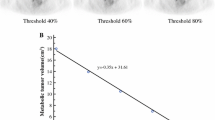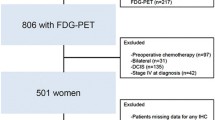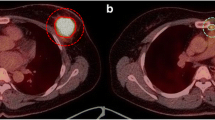Abstract
Purpose
The aim of this study was to assess whether the retention index (RI) determined using dual-phase 18F-fluorodeoxyglucose positron emission tomography/computed tomography (FDG PET/CT) reflects the malignant features of breast cancer.
Methods
A total of 1,523 patients with breast cancer were retrospectively evaluated. PET/CT scans were performed at 1 h and 2 h after FDG administration before treatment. The maximum standardized uptake value (SUVmax) at both time points (SUVmax1 and SUVmax2) in the primary tumour and RI were calculated. Primary tumour tissues were evaluated in terms of biological features, such as histology, nuclear grade, lymphovascular invasion and molecular subtype.
Results
Of the 1,523 patients, 463 (30.4%) had luminal A-like, 661 (43.4%) had luminal B-like, 229 (15.0%) had human epidermal growth factor receptor 2-positive (HER2-positive), and 157 (10.3%) triple-negative breast cancer. The median SUVmax1, SUVmax2 and RI values were 2.2, 2.3 and 2.6%, respectively. These metabolic parameters were correlated with tumour size, nodal metastasis, histology, nuclear grade, lymphovascular invasion, and molecular subtype (all P < 0.001). The median RI values were 0% in luminal A-like, 5.3% in luminal B-like, 6.9% in HER2-positive, and 11.4% in triple-negative breast cancer. RI was associated with malignant features when the tumour accumulated a significant amount of FDG. In a subanalysis of patients with tumours of stages T2 to T4, RI was correlated with nodal metastasis, histology, nuclear grade, and molecular subtype (luminal A-like 4.8%, luminal B-like 12.3%, HER2-positive 15.8%, and triple-negative 16.3%).
Conclusion
RI determined using delayed-phase FDG PET/CT is associated with malignant features in breast cancers with significant FDG uptake. Dual-phase imaging was helpful in distinguishing luminal A-like breast cancer from luminal B-like, HER2-positive, and triple-negative breast cancers.

Similar content being viewed by others
References
Siegel RL, Miller KD, Jemal A. Cancer statistics, 2017. CA Cancer J Clin. 2017;67:7–30.
Curigliano G, Burstein HJ, PW E, Gnant M, Dubsky P, Loibl S, et al. De-escalating and escalating treatments for early-stage breast cancer: the St. Gallen International Expert Consensus Conference on the Primary Therapy of Early Breast Cancer 2017. Ann Oncol. 2017;28:1700–12.
Goldhirsch A, Wood WC, Gelber RD, Coates AS, Thurlimann B, Senn HJ. Progress and promise: highlights of the international expert consensus on the primary therapy of early breast cancer 2007. Ann Oncol. 2007;18:1133–44.
Hong S, Li J, Wang S. 18FDG PET-CT for diagnosis of distant metastases in breast cancer patients. A meta-analysis. Surg Oncol. 2013;22:139–43.
Groheux D, Espie M, Giacchetti S, Hindie E. Performance of FDG PET/CT in the clinical management of breast cancer. Radiology. 2013;266:388–405.
Boerner AR, Weckesser M, Herzog H, Schmitz T, Audretsch W, Nitz U, et al. Optimal scan time for fluorine-18 fluorodeoxyglucose positron emission tomography in breast cancer. Eur J Nucl Med. 1999;26:226–30.
Lodge MA, Lucas JD, Marsden PK, Cronin BF, O’Doherty MJ, Smith MA. A PET study of 18FDG uptake in soft tissue masses. Eur J Nucl Med. 1999;26:22–30.
Hamberg LM, Hunter GJ, Alpert NM, Choi NC, Babich JW, Fischman AJ. The dose uptake ratio as an index of glucose metabolism: useful parameter or oversimplification? J Nucl Med. 1994;35:1308–12.
Kumar R, Loving VA, Chauhan A, Zhuang H, Mitchell S, Alavi A. Potential of dual-time-point imaging to improve breast cancer diagnosis with (18)F-FDG PET. J Nucl Med. 2005;46:1819–24.
Moon H, Noh WC, Kim HA, Kim EK, Park KW, Lee SS, et al. The relationship between estrogen receptor, progesterone receptor and human epidermal growth factor receptor 2 expression of breast cancer and the retention index in dual phase (18)F-FDG PET/CT. Nucl Med Mol Imaging. 2016;50:246–54.
García Vicente AM, Castrejón ÁS, Relea Calatayud F, Muñoz AP, León Martín AA, López-Muñiz IC, et al. 18F-FDG retention index and biologic prognostic parameters in breast cancer. Clin Nucl Med. 2012;37:460–6.
García Vicente AM, Soriano Castrejón A, Relea Calatayud F, Muñoz Madero V, Molina Garrido MJ, León Martín AA, et al. 18F-FDG semi-quantitative parameters and biological prognostic factors in locally advanced breast cancer. Rev Esp Med Nucl Imagen Mol. 2012;31:308–14.
García Vicente AM, Soriano Castrejón Á, León Martín A, Chacón López-Muñiz I, Muñoz Madero V, Muñoz Sánchez Mdel M, et al. Molecular subtypes of breast cancer: metabolic correlation with (1)(8)F-FDG PET/CT. Eur J Nucl Med Mol Imaging. 2013;40:1304–11.
Ozen A, Altinay S, Ekmekcioglu O, Albayrak R, Muhammedoglu A, Yigitbas H, et al. Dual-time (18)F-FDG PET/CT imaging in initial Locoregional staging of breast carcinoma: comparison with conventional imaging and pathological prognostic factors. Indian J Surg. 2016;78:382–9.
Edge SB, Byrd DR, Compton CC, Fritz AG, Greene F, Trotti A. AJCC cancer staging manual. 7th ed. New York: Springer; 2010.
Japanese Society of Nuclear Medicine. FDG-PET, PET/CT clinical practice guideline. 2012 (in Japanese). http://jsnm.sakura.ne.jp/wp_jsnm/wp-content/themes/theme_jsnm/doc/fdgpet_guideline2012_120912.pdf. Accessed 7 Jan 2019.
Kanda Y. Investigation of the freely available easy-to-use software ‘EZR’ for medical statistics. Bone Marrow Transplant. 2013;48:452–8.
Gatenby RA, Gillies RJ. Why do cancers have high aerobic glycolysis? Nat Rev Cancer. 2004;4:891–9.
Kadoya T, Aogi K, Kiyoto S, Masumoto N, Sugawara Y, Okada M. Role of maximum standardized uptake value in fluorodeoxyglucose positron emission tomography/computed tomography predicts malignancy grade and prognosis of operable breast cancer: a multi-institute study. Breast Cancer Res Treat. 2013;141:269–75.
Ekmekcioglu O, Aliyev A, Yilmaz S, Arslan E, Kaya R, Kocael P, et al. Correlation of 18F-fluorodeoxyglucose uptake with histopathological prognostic factors in breast carcinoma. Nucl Med Commun. 2013;34:1055–67.
Groheux D, Giacchetti S, Moretti JL, Porcher R, Espie M, Lehmann-Che J, et al. Correlation of high 18F-FDG uptake to clinical, pathological and biological prognostic factors in breast cancer. Eur J Nucl Med Mol Imaging. 2011;38:426–35.
Ueda S, Tamaki Y, Yano K, Okishiro N, Yanagisawa T, Imasato M, et al. Cosmetic outcome and patient satisfaction after skin-sparing mastectomy for breast cancer with immediate reconstruction of the breast. Surgery. 2008;143:414–25.
Soret M, Bacharach SL, Buvat I. Partial-volume effect in PET tumor imaging. J Nucl Med. 2007;48:932–45.
Acknowledgments
The authors thank Kazushi Marukawa and Masatsugu Tsujimura of Chuden Hospital for providing data regarding PET examinations. The authors also thank Ai Shimamoto for data management.
Author information
Authors and Affiliations
Corresponding author
Ethics declarations
Conflicts of interest
None.
Ethical approval
All procedures performed in studies involving human participants were in accordance with the ethical standards of the institutional research committee and with the principles of the 1964 Declaration of Helsinki and its later amendments or comparable ethical standards.
Informed consent
For this type of study, formal consent is not required.
Additional information
Publisher’s Note
Springer Nature remains neutral with regard to jurisdictional claims in published maps and institutional affiliations.
Rights and permissions
About this article
Cite this article
Sasada, S., Masumoto, N., Suzuki, E. et al. Prediction of biological characteristics of breast cancer using dual-phase FDG PET/CT. Eur J Nucl Med Mol Imaging 46, 831–837 (2019). https://doi.org/10.1007/s00259-019-4259-5
Received:
Accepted:
Published:
Issue Date:
DOI: https://doi.org/10.1007/s00259-019-4259-5




